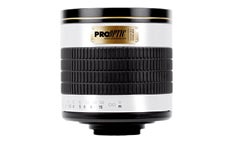Lens Test: ProOptic 500mm f/6.3 mirror lens
A welcome, if quirky, addition to your optical tool kit.

We may earn revenue from the products available on this page and participate in affiliate programs. Learn more ›

Lens Test: ProOptic 500mm f/6.3 mirror lens
A 500mm lens for under $200?
Believe it. Adorama’s ProOptic 500mm f/6.3 ($160, direct; www.adorama.com) shares all the strengths-and drawbacks- of inexpensive catadioptric lenses. Often called mirror or reflex lenses, these tele primes have more in common with telescopes than with conventional lenses. The ProOptic’s unusual design prevented us from testing it on our optical bench, but we did use it extensively in the field.
Using lenses and mirrors to fold and refold the light path in on itself, a 500mm mirror lens is a fraction of the size, weight, and price of a regular 500mm lens. This one weighs only 1.5 pounds and, when racked out, doesn’t reach 4.5 inches long-compare that with Canon’s $5,600 (street) 500mm f/4, which weighs more than 8.5 pounds and extends more than 15 inches. And on a DSLR with an APS-sized sensor, it scales up to the fullframe equivalent of 775mm.
With mirror lenses, defocused areas behind the subject go particularly creamy, with specular highlights (shimmering water or sparkling lights, for example) forming immediately recognizable rings that some photographers prize for their romance.
The ProOptic balanced nicely on our test camera, the Canon EOS-1Ds Mark III, and was easy to shoot handheld, especially in bright light. The oversized manual-focus ring contrasts nicely with the matte-finished white-metal barrel. Focusing is smooth but stiff, and distance scales are large and easily legible, with feet in blue and meters in black.
In several weeks of shooting, the ProOptic proved best at impressionistic landscapes, backyard bird feeder shots, and street photography. On the street, it allowed us to capture candid people pictures unobtrusively from half a block away. Its compact dimensions called little attention to our shooting, and distant subjects were generally flattered by the lens’ low-contrast, slightly soft imaging.
The single fixed aperture on all mirror lenses limits your exposure and depth-offield options. But at f/6.3, the ProOptic is 2/3-stop faster than the f/8 norm for this type of lens, making for slightly faster shutter speeds and a brighter finder image that’s easier to focus. Still, the finder image is somewhat dim unless you’re shooting in direct sunlight.
And you will need to see that finder image. Like most mirror lenses, the ProOptic does not allow for autofocus, only manual. Neither does it couple with a camera’s autoexposure system-you have to use the camera’s manual exposure mode.
A more contentious issue: The folded light path presents a number of mirrored surfaces within the lens barrel that light must reflect off, and each bounce takes a toll in contrast and sharpness.
But for true mirror lens fans (find ’em on www.flickr.com), that’s just the point. In fact, you often find evidence of mirror lens use in all forms of romanceoriented advertising-perfume, jewelry, and fashion ads, for example.
Our ProOptic images showed little evidence of edge falloff, and, like all mirror lenses, it’s immune to chromatic aberration. Because our test camera offered noise-free shooting at speeds up to ISO 1600, we dialed up the ISO when the fixed f/6.3 aperture was too slow.
This lens isn’t for all tele applications. Forget about when you need critical sharpness, more depth of field than f/6.3 can provide, or the responsiveness of a rapid AF system.
But under the right circumstances (that is, bright light), with the right subjects (distant people pictures and romantic or dreamy soft-focus scenes), it will prove money well spent, as well as a welcome, if quirky, addition to your optical tool kit. All the better if your DSLR has built-in shake control.
For $160, what are you waiting for?